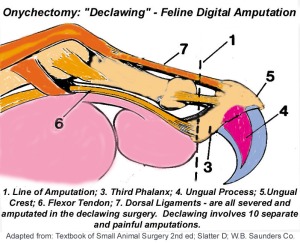
~~April 15, 2014~~
I have had cats all my life. I know how painful the scratches from those claws can be. I know how destructive they can be on furniture, clothes and any object that would serve as a scratching post. However, never once did I consider the practice of “declawing” even though I didn’t know what it entailed.
For some reason, I never considered that option. I was talking to an animal activist about the dear cat that I have now. She really really pesky and gets into plenty of trouble. Hence the name: Double Trouble.
The kids call her “Kitty“.
However, now that I’ve researched, I know that this would be something I wouldn’t do to any cat.
My friend Martin from …. http://mavadelo.wordpress.com/ …. made the following comment and I will “insert” it here:
“DO NOT DECLAW YOUR CAT…. keep your hands of the mittens of your kittens.”
~~Double Trouble~~
Onychectomy, popularly known as declawing, is an operation to surgically remove an animal’s claws by means of the amputation of all or part of the distal phalanges, or end bones, of the animal’s toes. Because the claw develops from germinal tissue within the third phalanx, amputation of the bone is necessary to fully remove the claw. The terms “onychectomy” (origin: Greek ὄνυξ onycho, nail + ἐκτομή ektome, excision) and “declawing” imply mere claw removal, but a more appropriate description would be phalangectomy, excision of toe bone.
Although common in North America, declawing is considered an act of animal cruelty in many countries (see “Declawing practices” below).
A lot of people take the idea of declawing their cat too lightly. Many do not understand what declawing is, thinking that it is some form of simply clipping the cat’s claws.

Too frequently, vets and clinic staff deliberately misinform and mislead clients into believing that declawing removes only the claws in the hopes that clients are left with the impression that the procedure is a “minor” surgery that doesn’t involve amputation of the end of the toe, ligaments and tendons.
In fact, this is a mutilating surgery that is banned in some countries due to its abusive and inhumane nature. These countries include, but are not limited to England, Scotland, Wales, Northern Ireland, Ireland, Italy, France, Germany, Austria, Switzerland, Norway, Sweden, Netherlands, Denmark, Finland, Slovenia, Spain, Portugal, Belgium, Brazil, Australia and New Zealand.

~~8 Reasons Why You Should Never Declaw Your Cats~~

Many people falsely assume that declawing is just like trimming your nails or getting a manicure. In reality, it is a painful and permanently crippling procedure.
The following are eight reasons why you should never declaw your feline friend

Ouch!

Cats scratch to exercise and enjoy themselves, maintain the condition of their nails, and stretch their muscles.

While we hope that your cat remains safely indoors at all times, if he or she were ever to get outside without claws, your cat would be far more vulnerable to predators and abusers.

Many people think that declawed cats are safer around babies, but in fact, the lack of claws makes many cats feel so insecure that they tend to bite more often as a means of self-protection.

Cats are in pain when they awake from the surgery, and the pain continues afterward. Nails can grow back inside the paw, causing extreme pain that you can’t see.

Without claws, even house-trained cats might start “doing their business” outside the litter-box in an attempt to mark their territory.

Our toes are crucial to our balance, and it’s no different for cats! Because of impaired balance after the procedure, declawed cats have to relearn how to walk, much as a person would after losing his or her toes.

Nearly two dozen countries — including Australia, England, and Japan — ban or severely restrict declawing surgeries. And many veterinarians in the United States refuse to perform the procedure.
~~What You Can Do Instead~~
Trim your cat’s nails regularly. When the cat is relaxed and unafraid, gently press on his or her toes until the claws extend. Use a pair of nail clippers, and cut only the tip of the nail, taking care not to damage the vein, or “quick.” The nail hook is what tears upholstery, so removing it virtually eliminates the potential for damage.
Buy multiple scratching posts. Ideally, you should have two or more scratching posts in your home. Make sure that they’re sturdy and tall enough to allow your cat to stretch (3 feet or taller). Soft, fluffy carpeted posts won’t fulfill your cat’s clawing needs, so look for rougher posts.
Teach your cat where to scratch and where not to scratch. Encourage your cat to use the scratching posts by sprinkling catnip on the posts once a week. Discourage your cat from scratching furniture by using a loud, firm voice whenever he or she starts to scratch—cats don’t like loud noises! Never use physical force. Instead, you might try using a squirt gun full of lukewarm water directed at your cat’s back.
~~SOURCES~~
http://en.wikipedia.org/wiki/Onychectomy
http://www.examiner.com/article/declawing-cats
http://www.peta.org/living/companion-animals/8-reasons-never-declaw-cats/#ixzz2yznPyFBM
http://www.examiner.com/article/declawing-a-cat-get-the-facts

~~Declawing practices~~
Laws and policies governing onychectomy vary around the world. For example, many European countries prohibit or significantly restrict the practice, as do Australia, New Zealand, Japan, and Turkey. It is banned in at least 22 countries. The list below gives an overview of the situation in different parts of the world.
~~Australia~~~
In Australia, declawing has never been common, and for all practical purpose, does not exist. Nationwide legislation was recently enacted that prohibits the declawing of cats except for medical need of the cat. The Australian Veterinary Association’s policy states: “Surgical alteration to the natural state of an animal is acceptable only if it is necessary for the health and welfare of the animal concerned. Performance of any surgical procedure for other than legitimate medical reasons is unacceptable.”
~~Brazil~~
In Brazil, declawing is not allowed by the Federal Council of Veterinary Medicine. [34]
~~Israel~~
In Israel, the Knesset Education Committee voted unanimously to send a bill banning the declawing of cats not for medical reasons. The bill has passed second and third readings on November 28, 2011, effectively making declawing a criminal offense with penalty of 1 year in prison or a fine of 75,000 Shekels.

~~Europe~~
In many European countries the practice is forbidden either under the terms of the European Convention for the Protection of Pet Animals or under Local Animal Abuse Laws, unless there it is for “veterinary medical reasons or for the benefit of any particular animal.” Some European countries go further, such as Finland, Estonia,[37] the Netherlands, Germany and Switzerland, where declawing cats for non-medical reasons is always illegal under their laws against cruelty to animals.
~~Austria~~
In Austria, the Federal Act on the Protection of Animals, in Section 7, states, surgical procedures “carried out for other than therapeutic or diagnostic purposes…are prohibited, in particular…declawing.”[
~~United Kingdom~~
In the United Kingdom, declawing was outlawed by the Animal Welfare Act 2006, which explicitly prohibited “interference with the sensitive tissues or bone structure of the animal, otherwise than for the purposes of its medical treatment.” Even before the 2006 Act, however, declawing was extremely uncommon, to the extent that most people had never seen a declawed cat. The procedure was considered cruel by almost all British vets, who refused to perform it except on medical grounds. The Guide to Professional Conduct of the Royal College of Veterinary Surgeons stated that declawing was “only acceptable where, in the opinion of the veterinary surgeon, injury to the animal is likely to occur during normal activity. It is not acceptable if carried out for the convenience of the owner … the removal of claws, particularly those which are weight bearing, to preclude damage to furnishings is not acceptable.”
~~United States~~
Declawing is legal in most U.S. jurisdictions. It is estimated that 25% of owned cats in the United States are declawed (Patronek 2001).

~~Published on Jan 6, 2014~~
Is declawing bad for cats? You bet it is! Jackson Galaxy sets the record straight in today’s episode of Cat Mojo.
Welcome to Cat Mojo! Each week Jackson will share his thoughts on everything from cat-related issues like declawing and squirt gun diplomacy to his craziest behind the scene stories as a cat behaviorist. Come join the feline frenzy, feel the mojo, share your love of cats and delve deep into the mind of Jackson Galaxy. We are all #TeamCatMojo!
Alternative to declaw: https://www.softpaws.com/
We ALL are connected through NATURE!!

We ALL are ONE!!








https://www.softpaws.com/
I had a cat that tore my couch to shred. I would never declaw for any reason, but I found these worked great.
LikeLike
I’ve used those …. they look cute. To get them on “Double Trouble” is almost impossible. She even hyper-ventilates.
Then she will bite and pull each and every on off!! So, we mostly trim the claws. She leaves her mark on plenty of things around the house!! LOL …
Hugs, sweets!!
LikeLike
Although I appreciate to see that someone invented a means for people to “declaw without declawing” I would like to note that the act of clawing is a necessary activity for cats. Besides it should make clipping the nails not needed it is a means to express themselves also. A cat can purr and claw for a multiple of reasons ranging fom joy to frustration and anger. Please, if you have the best interest for your cat in mind, provide a scratchpole or scratch bench for them. This is always prefered above any form of “declawing” be it real or artificial declawing.


more info http://www.animalbehavior.org/ABSAppliedBehavior/article-applied-behavior/why-cats-scratch-things
LikeLike
Reblogged this on My Drops Of Jupiter.
LikeLike
Thank you so much for the reblog!! Really appreciated!! hugs …..
LikeLike
The law in the Netherlands is not specifically about cats, the “health and welfare” law of 1992 simply states (among other things)
welfare
The Act provides that:
it is forbidden to cause an animal unnecessary pain or injury or to harm. his health or well-being Thus, it is prohibited, for example, to transport cows with a full udder or to deploy a dog as a draft animal;
it is forbidden to withhold the necessary care an animal;
it is forbidden to separate young animals from the older animal
before they reach an age determined by law
it is in principle prohibited to perform physical interventions in animals unless permitted by special law
Allowed are spaying and neutering and veterinary interventions for which a need exists
There are also requirements for the way in which animals may be slaughtered, the situations for slaughter and the persons by whom they may be slaughtered. Conditions are also imposed on the slaughter with previous stunning. This provision is of great importance for ritual slaughter.
LikeLike
I think I’m loving your country more and more … Hugs, my brother!!
LikeLike
hhmm few typos 😀 sorry hun AWOOOOOOOOHUGZZZ ❤
LikeLike
Will have to check!!! Thank you! hugs …. 🙂
LikeLike
no no..I as in ME made a few typos 😛
LikeLike
Oh, I thought you meant the post!! LOL … I was heading that way!!
😎
LikeLike
Reblogged this on Mavadelo's mindscape and commented:


Post by my good friend DrRex from it is what it is. My own addendum in this is thefollowing as a reply to a commenter
Although I appreciate to see that someone invented a means for people to “declaw without declawing” I would like to note that the act of clawing is a necessary activity for cats. Besides it should make clipping the nails not needed it is a means to express themselves also. A cat can purr and claw for a multiple of reasons ranging fom joy to frustration and anger. Please, if you have the best interest for your cat in mind, provide a scratchpole or scratch bench for them. This is always prefered above any form of “declawing” be it real or artificial declawing.
more info http://www.animalbehavior.org/ABSAppliedBehavior/article-applied-behavior/why-cats-scratch-things
LikeLike
I have two declawed cats. They were this way when I got them in Singapore as kittens. I have had cats all my life, these are the first who have been this way. I didn’t understand it, why they did it to them. They are both 14 now, they are fine now. I always thought they were rather sad though. I wouldn’t ever think to do this to a cat myself.
LikeLike
Me neither …. it’s to the owner’s convenience, I think!
LikeLike
I’m a horrible person. I had my cat declawed after she opened my leg from top to bottom one day while playing. Had no idea that was what they did. The shelter I adopted her from recommended I have her declawed when I had her spayed, and the vet also recommended it be done at the same time. Now I don’t blame her a bit for tripping me so many times. Mea culpa.
LikeLike
You’re excuses bc u didn’t know. Now u know better! Hugs ….
LikeLike
That doesn’t make you a horrible person.
It makes you a person who did a bad thing out of ignorance.
In the future, remember that trimming every two weeks will mean no one ever gets sliced on accident. I have a 13 lb male cat who is solid muscle, and even when he tried to climb me because he was terrified by an earthquake, all I got was some welts because we keep his claws trimmed.
LikeLike
Agree, Bjorn …. thank you for you visit and comments. Be well ….. Peace!!!
LikeLike
Pingback: To “declaw” or to not “declaw” … PawProject.Org!! | It Is What It Is
Reblogged this on The WordPress Blogatorium and commented:
Reblogged to the Blogatorium. discover new blogs, make new friends, Join our communities, have fun https://www.facebook.com/groups/thewordpressblogatorium/ (and for non facebook users https://plus.google.com/u/0/107780884163598533386 …. Just started!!
LikeLike